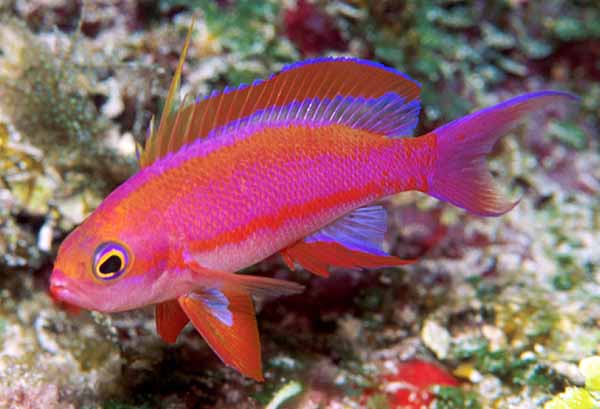Pseudanthias randalli: Unterschied zwischen den Versionen
Es (Diskussion | Beiträge) (Die Seite wurde neu angelegt: „__NOTOC__ <!--†--> =='''{{a|Roger Lubbock|Lubbock}} & {{a|Gerald R. Allen|Allen}}, 1978)'''== <!--------------------------- Taxonavigation ----------------…“) |
Es (Diskussion | Beiträge) (→Literatur) |
||
| (4 dazwischenliegende Versionen desselben Benutzers werden nicht angezeigt) | |||
| Zeile 1: | Zeile 1: | ||
__NOTOC__ <!--†--> | __NOTOC__ <!--†--> | ||
| − | =='''{{a|Roger Lubbock|Lubbock}} & {{a|Gerald R. Allen|Allen}}, 1978)'''== | + | =='''({{a|Roger Lubbock|Lubbock}} & {{a|Gerald R. Allen|Allen}}, 1978)'''== |
<!--------------------------- Taxonavigation --------------------------> | <!--------------------------- Taxonavigation --------------------------> | ||
{| style="width:100%; background:#fcfcfc; margin-top:2em;" | {| style="width:100%; background:#fcfcfc; margin-top:2em;" | ||
| Zeile 17: | Zeile 17: | ||
<!--------------------------- Platz für Abbildungen --------------------------> | <!--------------------------- Platz für Abbildungen --------------------------> | ||
| style="width:50%; padding:0 1em; background:#f5fffa; border:1px solid #ccc;" id=mf-sow| | | style="width:50%; padding:0 1em; background:#f5fffa; border:1px solid #ccc;" id=mf-sow| | ||
| − | [[Datei:Pseudanthias | + | [[Datei:Pseudanthias randalli.jpg|600px|thumb|left|''Pseudanthias randalli'' Männchen, von Kwajalein, Marshall Islands -- (C) {{aut|J. Johnson}} (2017) in: ''Zootaxa'', '''4341''' (1): 67-76.]] |
|} | |} | ||
== Typen == | == Typen == | ||
| Zeile 24: | Zeile 24: | ||
'''Typusfundort:''' Große Höhle an vertikalem Drop-off, Baring, Olango Island, Straße von Cebu, Philippinen. | '''Typusfundort:''' Große Höhle an vertikalem Drop-off, Baring, Olango Island, Straße von Cebu, Philippinen. | ||
== Etymologie == | == Etymologie == | ||
| − | Das Art-Epitheton ehrt {{a|}}. | + | Das Art-Epitheton ehrt {{a|John E. Randall}}. |
== Verbreitung == | == Verbreitung == | ||
| Zeile 30: | Zeile 30: | ||
== IUCN Status == | == IUCN Status == | ||
| − | [http://www.iucnredlist.org/details/ IUCN ('''I'''nternational '''U'''nion for '''C'''onservation of '''N'''ature and Natural Resources) = Weltnaturschutzunion '''Rote Liste bedrohter Arten'''] | + | [http://www.iucnredlist.org/details/69591683/0 IUCN ('''I'''nternational '''U'''nion for '''C'''onservation of '''N'''ature and Natural Resources) = Weltnaturschutzunion '''Rote Liste bedrohter Arten'''] |
[[Datei:Status iucn3.1.svg.png|300px|mini|Die Gefährdungsstufen gemäß IUCN | [[Datei:Status iucn3.1.svg.png|300px|mini|Die Gefährdungsstufen gemäß IUCN | ||
| Zeile 43: | Zeile 43: | ||
'''NE''' Not Evaluated (nicht beurteilt)]] | '''NE''' Not Evaluated (nicht beurteilt)]] | ||
| − | '''Status:''' Stand 10.11.2017: ''' | + | '''Status:''' Stand 10.11.2017: '''LC''' Least Concern (nicht gefährdet)<br /> |
| + | '''Grund für die Gefährdungseinstufung:''' Es sind keine Gründe für eine Gefährdung der Art bekannt. | ||
==Literatur== | ==Literatur== | ||
{{Lubbock & Allen, 1978}}[: 260, Figs. 1-2, !! als ''[[Anthias randalli]]''] | {{Lubbock & Allen, 1978}}[: 260, Figs. 1-2, !! als ''[[Anthias randalli]]''] | ||
{{Myers & Shephard, 1980}}[: 316 (Blue Hole, Orote Peninsula, Guam) <span style="color: red; text-decoration: line-through;">''Pseudanthias randalli''</span> -->''[[Pseudanthias tequila]]''] | {{Myers & Shephard, 1980}}[: 316 (Blue Hole, Orote Peninsula, Guam) <span style="color: red; text-decoration: line-through;">''Pseudanthias randalli''</span> -->''[[Pseudanthias tequila]]''] | ||
| + | {{DEB84g}}[: 349, Zeichnung, als ''[[Anthias randalli]]''] | ||
| + | {{Masuda et al., 1984}}[: 137, Autor: {{aut|Katayama}}, als ''[[Pseudanthias randalli]]''] | ||
| + | {{DEB91}}[: 126, Farbfoto] | ||
| + | {{MA1a}}[: 950, Farbfoto] | ||
{{Kuiter, 2004}}[: 61, unnummeriertes Farbfoto, figs A and B (Farbfotos; Palau, Saipan und Guam), <span style="color: red; text-decoration: line-through;">''Pseudanthias'' cf ''randalli''</span> -->''[[Pseudanthias tequila]]''] | {{Kuiter, 2004}}[: 61, unnummeriertes Farbfoto, figs A and B (Farbfotos; Palau, Saipan und Guam), <span style="color: red; text-decoration: line-through;">''Pseudanthias'' cf ''randalli''</span> -->''[[Pseudanthias tequila]]''] | ||
{{Gill et al., 2017b}}[: 72, Fig. 4D, Farbfoto, Vergleich] | {{Gill et al., 2017b}}[: 72, Fig. 4D, Farbfoto, Vergleich] | ||
Aktuelle Version vom 10. November 2017, 12:04 Uhr
(Lubbock & Allen, 1978)
|
Familie: Serranidae SynonymeAnthias randalli Lubbock & Allen, 1978 Lokale Bezeichnung |
Typen
Holotypus: BMNH 1977.1.21.1.
Paratypen: AMS I.19756-001 (1); BMNH 1976.1.21.2-3 (1, 1); BPBM 9532 (1), 19983 (2); MHNG 1551.39 (1); RMNH 28182 [ex WAM P25239-002] (2); USNM 217534 (1); WAM P25233-007 (6), P.25239-002 (8), P.25628-001 (3).
Typusfundort: Große Höhle an vertikalem Drop-off, Baring, Olango Island, Straße von Cebu, Philippinen.
Etymologie
Das Art-Epitheton ehrt John E. Randall.
Verbreitung
Östlicher Indischer Ozean, West- und Zentralpazifik: Indonesien östlich zu den Marshall Inseln und vielleicht bis zum Johnston Atoll, nördlich bis zu den Ryukyu Inseln, südlich bis nach Neukaledonien.
IUCN Status

CR Critically Endangered (vom Aussterben bedroht)
EN Endangered (stark gefährdet)
VU Vulnerable (gefährdet)
NT Near Threatened (potenziell gefährdet)
LC Least Concern (nicht gefährdet)
RE Regionally Extinct (regional oder national ausgestorben)
DD Data Deficient (ungenügende Datengrundlage)
NE Not Evaluated (nicht beurteilt)
Status: Stand 10.11.2017: LC Least Concern (nicht gefährdet)
Grund für die Gefährdungseinstufung: Es sind keine Gründe für eine Gefährdung der Art bekannt.
Literatur
- Lubbock, R. & Allen, G.R. 1978. A distinctive new Anthias (Teleostei: Serranidae) from the western Pacific. Records of the Western Australian Museum, 6 (2): 259-268. (PDF) Zitatseite [: 260, Figs. 1-2, !! als Anthias randalli]
- Myers, R.F. & Shepard, J.W. 1980. New records of fishes from Guam, with notes on the ichthyofauna of the southern Marianas. Micronesica, 16: 304–347. Zitatseite [: 316 (Blue Hole, Orote Peninsula, Guam) Pseudanthias randalli -->Pseudanthias tequila]
- Debelius, H. 1984. Kleine Barsche - groß betrachtet. 3. Teil: Fahnenbarsche. Die Aquarien- und Terrarienzeitschrift (DATZ), 37 (9): 345-350. Zitatseite [: 349, Zeichnung, als Anthias randalli]
- Masuda, H., Amaoka, K., Araga, C., Uyeno, T. & Yoshino, T. (Eds.) 1984. The fishes of the Japanese Archipelago. Tokai University Press, Tokyo, xxii + 437 pp. Zitatseite [: 137, Autor: Katayama, als Pseudanthias randalli]
- Debelius, H. 1991. Visit Indonesia 1991. UWF, (2): 121-131. Zitatseite [: 126, Farbfoto]
- Baensch, H.A. & Debelius, H. 1992. Meerwasser-Atlas Band 1. Mergus-Verlag, Melle. 1. Auflage. Zitatseite [: 950, Farbfoto]
- Kuiter, R.H. 2004. Basslets, Hamlets and Their Relatives. A Comprehensive Guide to Selected Serranidae and Plesiopidae. TMC Publishing, Chorleywood, 216 pp. Zitatseite [: 61, unnummeriertes Farbfoto, figs A and B (Farbfotos; Palau, Saipan und Guam), Pseudanthias cf randalli -->Pseudanthias tequila]
- Gill, A.C., Tea, Y.-K. & Senou, H. 2017. Pseudanthias tequila, a new species of anthiadine serranid from the Ogasawara and Mariana Islands. Zootaxa, 4341 (1): 67-76. (doi) Zitatseite [: 72, Fig. 4D, Farbfoto, Vergleich]
